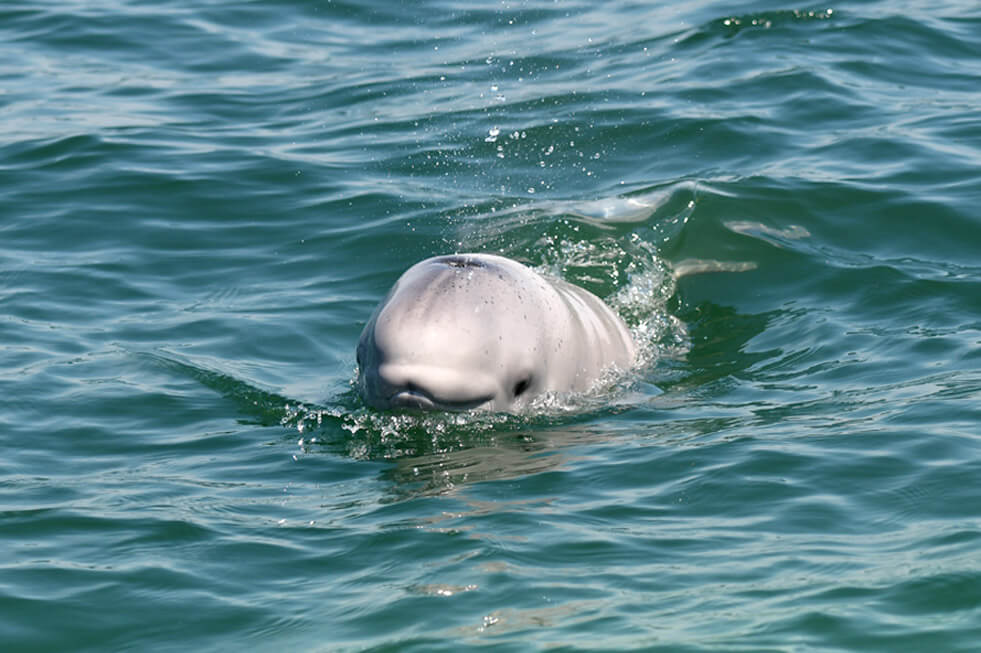They’re about one-third the size of an adult and still stick close to their mothers’ sides. Calves of several species have been seen along the shores of the St. Lawrence almost everywhere in recent days.
On a calm sea at long last free from a thick blanket of fog, a naturalist and her passengers had the privilege of observing small groups of harbour porpoises – including females with their calves – off the coast of Percé. The same day, just off Île Plate, a fin whale mother and her young are also seen.
 Between Tadoussac, Les Bergeronnes and Les Escoumins, the fin whale Trou and her calf swim side by side. They have been observed here since early July. A juvenile humpback – evidently weaned given that it arrived alone – made a remarkable entrance into the Estuary. The female humpback Tic Tac Toe examines the animal. “I would have liked to see what was going on under the water! There was quite a bit of interaction,” points out a GREMM research assistant who was present on the water at the time. Finally, the two humpbacks departed, swimming away in sync with one another.
Between Tadoussac, Les Bergeronnes and Les Escoumins, the fin whale Trou and her calf swim side by side. They have been observed here since early July. A juvenile humpback – evidently weaned given that it arrived alone – made a remarkable entrance into the Estuary. The female humpback Tic Tac Toe examines the animal. “I would have liked to see what was going on under the water! There was quite a bit of interaction,” points out a GREMM research assistant who was present on the water at the time. Finally, the two humpbacks departed, swimming away in sync with one another.
Newborn belugas have also been observed in the Saguenay and in the St. Lawrence Estuary. When they are born, belugas measure nearly half the length of their mothers (and already longer than yours truly is tall). During their first year of life, belugas are café au lait in colour, after which they turn greyish-blue, which explains the nickname given to them by French speakers: bleuvet. Young belugas stay with their mothers for 20 to 30 months before they are able to live independently.
Farther down the Estuary, off the coast of Matane, a blue whale calf is seen with its mother, B522. This is the fourth mother-calf pair observed this season for this species. If researchers from the Mingan Island Cetacean Study were incredulous when they received the photos, it’s because no blue whale calf had been observed in these waters since… 2008!
In Gaspé Bay, a white-sided dolphin hurls itself completely out of the water while the rest of the herd swims alongside. In this species, newborns already measure half the length of adults. Off Cap-des-Rosiers, two right whales and one blue whale are observed.
On the other side of the river, approximately 12 nautical miles south of Sept-Îles’ Marconi Peninsula, 10 humpback whales are seen on Sunday. Among them is the calf of Tracks, who can be recognized by its zipper-shaped scar. This calf had been observed earlier in the season on the Gaspé side of the river.
Shark!
In Port-Cartier, a recreational boater out for a day of fishing observes a porpoise and a minke whale in the distance when a triangular black shape emerges from the water surface: it’s a basking shark! She observes it from a distance before it disappears.
Another shark of this species plies the waters beyond Percé Rock and around the docks of Bonaventure Island.
Click on the whale or the seal icon to find out more about the corresponding observation (specie, number of individuals, info, pictures). To enlarge the map, click on the top right corner icon.
To see the list of the observations, click on the top left corner.
This map represents an order of magnitude rather than a comprehensive survey.
Legend for the whales
Light grey: Beluga
Dark grey: Fin Whale
Black: Minke Whale
Light blue: Humpback Whale
Dark blue: Blue Whale
Violet: Right Whale
Legend for the dolphins
Brown: Harbour Porpoise
Light grey: White-sided Dolphins
Legend for the seals
Grey: Grey Seal
Brown: Harp Seal
Kaki: Harbour Seal
Legend for the sharks
Light grey: Basking Shark





